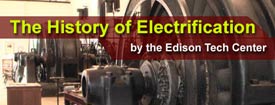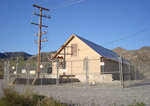The
History of Alternating Current:
AC Power History and Timeline
Alternating current power drives our world today. AC power was the next logical step after DC power was established. The founders, developers, and visionaries of AC power are depicted below. Click on the pioneer to learn more, or see the list below.
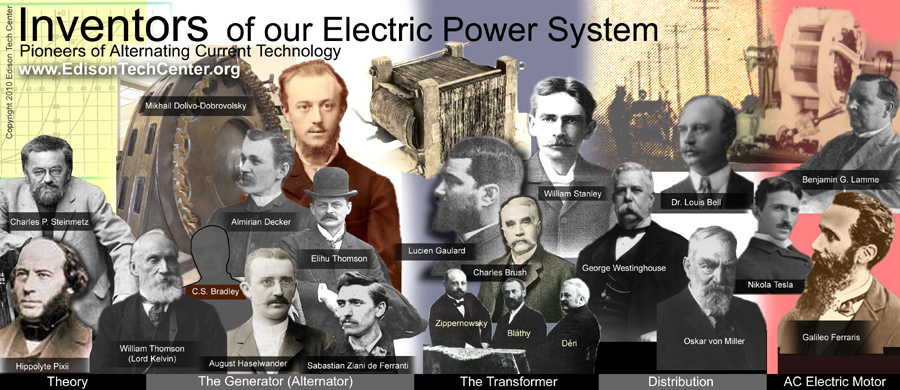
Below: The inventors, including the first year they developed the technology or improved the technology (most continued to improve the technology after that date, it was rarely a one time achievement)
|
The AC generator:
|
The Transformer:
|
|
The AC motor:
|
|
Notes:
Stanley and Thomson had worked on motor, but it had a commutator.
Ferraris invented an AC three phase motor without commutator. Tesla
and Oliver Shallenberger also were working on the motor a couple of
months behind Ferraris.
To learn about important early sites and installations of AC power please see our History of Power Transmission and Electrification page:
| AC Power Development Timeline: |
1835
- Hippolyte Pixii builds the first alternator. Pixii builds
a device with a rotating magnet. He doesn't know how to make his creation
useful since all the other experimenters of the time were building
DC devices. Others like Faraday and Henry were experimenting at the
time with primitive electric motors using electromagnets.
1855 - Guillaume Duchenne uses alternating current in electrotherapeutic
triggering of muscle contractions. (Paris, France) AC
power is not viewed as useful for anything else at the time.
1878 - Ganz Company starts working with single phase AC power
systems in Budapest, Austro-Hungary
1879 - London: Walter Baily makes a copper disc rotate using alternating current (this is a weak early AC motor) which was not effective for bearing any load.
The 1880s: This decade proved to be an exciting time for the development of electric power, read below to find out some of the major developments by year.
1882 - London, Sabastian Ferranti (Englishman with an Italian parent) works at Siemens Brothers firm in London with Lord Kelvin (William Thompson), and Ince. With the help of Lord Kelvin Ferranti pioneers early AC power technology, including an early transformer. Later on John Gibbs and Lucien Gaulard would base their designs off of Ferranti.
1884
1884 - Turin, Italy: Lucien Gaulard develops transformers
and the power transmission system from Lanzo to Turino. The demonstration
of AC power includes a 25 mile trolley with step down transformers
that allow low power Edison incandescent lights to light the path
along with arc lamps. Galileo Ferraris
was head of the Electrical Department. The next year Ferraris would
invent the polyphase motor.
1885
1885 - Ferraris conceives the idea of the first polyphase AC
motor: " In the summer of 1885 he conceived the idea that two
out-of-phase, but synchronized, currents might be used to produce
two magnetic fields that could be combined to produce a rotating field
without any need for switching or for moving parts. "
1885 - Elihu Thomson at Thomson-Houston starts experimenting with AC power (the first company in the US to start work on AC)
1885 - George Westinghouse is intrigued by AC power and buys North American rights to Gaulard and Gibbs system for $50,000
1885 - George Westinghouse orders a Siemens alternator (AC generator) and a Gaulard and Gibbs transformer. Stanley begin experimenting with this system.
1886
An important year for AC power
1886
- Great Barrington, Massachusetts
- the first full AC power system in the world is demonstrated
using step up and step down transformers. The system was built by
William Stanley and funded by Westinghouse.
1886 - November - Buffalo, New York receives the first commercial
AC power system in the USA. This system designed by George Westinghouse,
William Stanley, and Oliver
B. Shallenberger
1886
- William Stanley designs an improved version of the Siemens single
phase alternator
1886 - Fall - Elihu Thomson's AC
power system is rejected by the patent office. Westinghouse is already
far ahead, having sold its system commercially already.
1886 - Nikola Tesla tries to sell his AC power system to investors in New York City, but it fails to be of interest in a city which is already heavily invested in DC power systems. Other inventors around the world also promoting AC power have similar problems. This is especially due to the fact that no one has yet to invent an AC electric motor which is efficient.
1886 - Otto Blathy comes to the USA and Thomas Edison buys options on the Z.B.D. Transformer. This would put him in the position to rival Westinghouse that controlled the Gaulard and Gibbs transformer patent. Later Edison decides that it is not worth going into AC and drops his options on the Z.B.D. Transformer.
1887
1887 - C.S. Bradley builds the first AC 3 phase generator. Up until this time Siemens and Westinghouse had been producing single phase AC generators. The 3 phase system would be a great improvement.
1887 - F. Augus Haselwander develops the first AC 3 phase generator in Europe. He is behind Bradley by a couple months and it is generally believed that he built his design independently of Bradley.
1887 - Sabastian Ferranti designs Depford Power Station in London. When it is completed in 1891 it would be an important early site in AC power history.
1888
1888
- Mikhail Dolivo-Dobrovsky in Germany builds his first AC polyphase
generator. He works for AEG. (Allgemeine Elektricitäts-Gesellschaft)l One
of the first three phase AC generators in the world. This one
was created for the Electrical Exposition in Frankfurt,Germany
in 1891. 1889 and Beyond
1890 - December 17th Charles Proteus Steinmetz publishes introduces
new mathematic solutions to solve puzzles of the behavior of AC power with his article:
"Note on the Law of Hysteresis" in Electrical Engineer issue number 137.
1891
- Frankfurt, Germany: First distance
power transmission (for electric power utility) Lauffen to
Frankfurt 109 miles. The entire system was designed by Dobrovolsky from
generator to electric motor. Many important figures of AC power were
invited to the event, at the Congress Dinner Galileo
Ferraris was hailed as “the father of three-phase current.” 1892
- Charles P. Steinmetz
goes before the AIEE and presents his latest paper on hysteresis.
More on hysteresis >
1888 - April - Galileo Ferraris
makes public his AC polyphase motor first conceived in 1885. His motor
works without a commutator, this development finally makes the AC
motor efficient, and therefore competitive with DC motors. The motor
report was first published at the Royal Academy of Sciences in Turin.
Westinghouse read the report of Ferraris and saw a chance for AC systems
to become much more marketable.
1888 - May 15 - Tesla
stands before the AIEE showing his polyphase motor. Elihu Thomson
was there and some in the group seemed to be impressed. Within
a week Westinghouse had agents meeting with Tesla and inspecting
his equipment, with an eye to forging an agreement about acquiring
patent rights.
Tesla's
progress on the motor is slightly ahead of Oliver Shallenberger's
3 phase electric motor. Shallenberger
was already working for Westinghouse.
Tesla claims he "dreamed up" the first polyphase motor before
Galileo Ferraris. Later
at a trial a US court sides
with Tesla despite the fact that Tesla has no proof besides witness
testimony.Read more here
William Stanley credits Tesla not with inventing the induction motor, but
taking Ferraris's work and fully realizing it's commercial potential. Tesla "neatly"
organized Ferraris's work into several patents and fully understood the invention.
He filed for copyright claiming the invention as his own.
Steinmetz was the first person to
understand AC power from a mathematical point of view. After his paper
he is hired by General Electric Company and joins forces with Elihu
Thomson and William Stanley. Steinmetz would go on to improve and
troubleshoot future AC power systems.
Paper: On the Law of Hysteresis by Chas. Proteus Steinmetz. 1892. AIEE
1893 - Redlands
Power House - the first commercial installation of 3 phase AC
power, 40 Hz.
1895 - Folsom
Power House - The first installation of modern AC power in
the USA: 3 Phase AC at 60 Hz.
1897 - Mechanicville Power Station
- Charles P. Steinmetz experiments with a unique single phase AC power
transmission system.
1895 - Westinghouse builds the power system for the Adams
Power Station at Niagara Falls. Benjamin Garver Lamme
is the principal engineer of the operation. General Electric builds
the 25 mile power transmission system from the Niagara power house
to Buffalo, NY which is made operational in 1896.
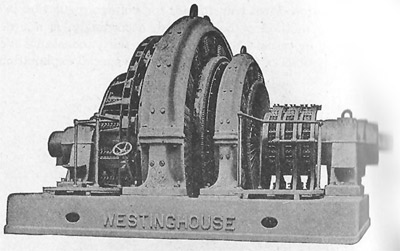
1900s - Three Phase AC power is fully established as the principle
source of power for the world
|
|
Mechanicville Power Station, Mechanicville, New York 1897 |
|
|
Schaghticoke Power Station and Steinmetz's monocyclic power experiment |
Great Barrington 1886 The first AC power distribution system using transformers |

Ernst F.W. Alexanderson - pioneer in wireless and TV transmission 
Ernst Julius Berg - developed two way wireless audio communication. Worked on AC power. 
Charles F. Brush - pioneered Generators, lamps, trolleys and an early profitable industry. 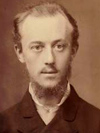
Mikhail O. Dolivo-Dobrovolsky - pioneer of 3 phase AC power systems 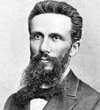
Galileo Ferraris - Early AC power pioneer. Inventor of the polyphase AC motor. 
Oskar von Miller - early pioneer of AC and HVDC power in Germany 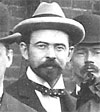
Edwin W. Rice, Jr - AC power systems pioneer. Leader of the electrical industry. 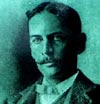
William Stanley - inventor of the first modern transformer, heart of the AC power system. 
Charles P. Steinmetz - pioneer of AC power systems, first person to understand AC power mathematically. 
Nikola Tesla - improved upon many technologies, most notably AC power. 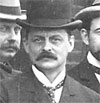
Elihu Thomson - improved DC and AC power systems, arc lights 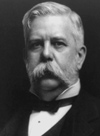
George Westinghouse - innovator in many technologies, business leader. |
Related Topics:
|
Transformers |
History of Electrification - Sites |
High Voltage DC Transmission |
12 Major Forms of Electric Light |
Electric Motors |
More Stuff |
Article by M.Whelan, Joseph Cunningham and S.Rockwell
Sources:The Power Makers: Steam, Electricity, and the Men who Invented Modern America
Networks of Power: Electrification in Western Society, 1880-1930 by Thomas Parke Hughes
Galileo Ferraris Biography. IncrediblePeople.com
Wikipedia: Benjamin G. Lamme, Ferranti, Ferraris
Rochester Historical Society
Great Barrington Historical Society
Workshop of Engineers. John Miller. 1953
Interview with Tom Blalock. Edison Tech Center 2014.
"On the Law of Hysteresis" by Charles Proteus Steinmez. AIEE. 1892
For use of Edison Tech Center images and videos see our licensing agreement.


